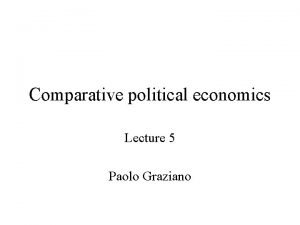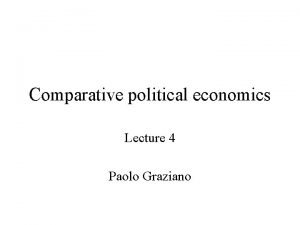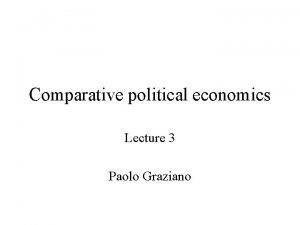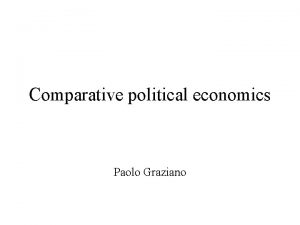Comparative political economics Lecture 2 Paolo Graziano The









- Slides: 9

Comparative political economics Lecture 2 Paolo Graziano

The Westminster model of democracy • Majority principle • British parliamentary and governmental institutions • Need for alternation that prevents ‘elective dictatorship’ • Prerequisite: homogeneous societies • UK, Canada… • … Australia, New Zealand … • … Barbados.

The case of UK I • concentration of executive power in one- party and bare-majority cabinets (large minority is excluded from power) – exception with minority cabinets in the ’ 70 s • cabinet dominance vis-à-vis Parliament (but possible – although rare - vote of no confidence) • two-party system: Conservative and Labour party (but recently increase of the Liberal Democrats) • majoritarian (single-member districts and ‘first past the post’) and disproportional (votes vs. seats) electoral system. • interest group pluralism

The case of the UK II • unitary and centralized government • concentration of legislative power in asymmetrical bicameral legislature: House of the Commons and House of the Lords • flexible (“unwritten”) Constitution • absence of judicial review: Parliament is the sovereign authority (except for EU control…) • central bank controlled by the executive (1997: power to set interest rates)

The consensus model of democracy • • • more usable for ‘plural’ societies it contributes to conflict reduction… …guaranteeing strong minorities… …limiting the power of majorities. Switzerland, Belgium … … and the European Union.

The cases of Switzerland/Belgium I • executive power-sharing in broad coalition cabinets • executive-legislative balance of power (possible government instability) • multiparty system (religious, socioeconomic and linguistic cleavages) • proportional representation • interest group corporatism (agreements reached among few strong political and social actors)

The cases of Switzerland/Belgium II • federal and decentralized government • strong bicameralism (with the partial exception of Belgium) • constitutional rigidity: need of ‘supermajorities’ in order to change • judicial review (but not in Switzerland) • central bank independence

A supranational case of CD: the EU I • executive power-sharing in broad coalition cabinets • executive-legislative balance of power • multiparty system • proportional representation • interest group corporatism

A supranational case of CD: the EU II • • • federal and decentralized government strong bicameralism constitutional rigidity judicial review central bank independence
















